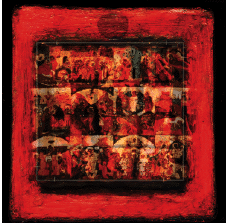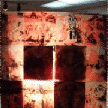A 2″ square lenticular pin is being carried by the Gift Shop of the Brooklyn Museum of Art.
“Happy Home”
48×48 inches
©Dorothy Simpson Krause 2001
“Happy Home” was composed from two scans; a collage using a package of “Happy Home” needles and an icon, “The Twelve Feasts of the Church”, from The Art Complex Museum, Duxbury, MA.







A fresco surface was prepared by wrapping tape around a masonite panel, pouring hydrocal plaster onto the surface and spreading and texturing it with a large spackling tool. The emulsion layer, which can be handled like a large “decal” when it is dry, was glued to the hardened fresco surface and burnished down with encaustic. Touch-ups were made with oil sticks and paint.


As a separate layer, a lenticular print was added to the center of the image. The book of needles and twelve frame icon were “interlaced”, (cut and reassembled in vertical strips by Flip! software), and printed on Rexam clear film. A Coda laminator adhered the print to a sheet of clear plastic with a series of parallel lens or lenticules embossed into the surface. When the lens are aligned with the image, the viewer sees only one frame at a time creating a sense of movement as the viewing angle changes. Squares of metallic papers were added from behind to give additional luminance. The lenticular overlay, attached with brass brackets, creates both a physical and metaphorical discontinuity between the sacred and mundane.
Dorothy Simpson Krause • 800 Lakeside Circle #605, Pompano Beach, FL 33060 • 781 424 5276 • DotKrause@DotKrause.com